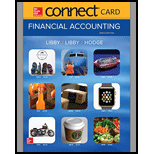
Connect Access Card for Financial Accounting
9th Edition
ISBN: 9781259738678
Author: Robert Libby, Patricia Libby, Frank Hodge Ch
Publisher: McGraw-Hill Education
expand_more
expand_more
format_list_bulleted
Question
Chapter 7, Problem 7.20E
To determine
Explain the effects of the change in inventory and accounts payable on
Expert Solution & Answer
Want to see the full answer?
Check out a sample textbook solution
Students have asked these similar questions
Can you solve this general accounting question with accurate accounting calculations?
don't give me incorrect solution
I mistakenly submitted blurr image please comment i will write values.
please dont Solve with incorrect values otherwise unhelpful.
Chapter 7 Solutions
Connect Access Card for Financial Accounting
Ch. 7 - Why is inventory an important item to both...Ch. 7 - Prob. 2QCh. 7 - Prob. 3QCh. 7 - Prob. 4QCh. 7 - Prob. 5QCh. 7 - The chapter discussed tour inventory costing...Ch. 7 - Prob. 7QCh. 7 - Contrast the effects of LIFO versus FIFO on...Ch. 7 - Contrast the income statement effect of LIFO...Ch. 7 - Prob. 10Q
Ch. 7 - Explain briefly the application of the LCM concept...Ch. 7 - Prob. 12QCh. 7 - Consider the following information: ending...Ch. 7 - The inventory costing method selected by a company...Ch. 7 - Which of the following is not a component of the...Ch. 7 - Consider the following information: beginning...Ch. 7 - Consider the following information: beginning...Ch. 7 - An increasing inventory turnover ratio a....Ch. 7 - If the ending balance in accounts payable...Ch. 7 - Which of the following regarding the lower of cost...Ch. 7 - Which inventory method provides a better matching...Ch. 7 - Which of the following is false regarding a...Ch. 7 - Prob. 7.1MECh. 7 - Recording the Cost of Purchases for a Merchandiser...Ch. 7 - Identifying the Cost of Inventories for a...Ch. 7 - Inferring Purchases Using the Cost of Goods Sold...Ch. 7 - Prob. 7.5MECh. 7 - Matching Inventory Costing Method Choices to...Ch. 7 - Reporting Inventory under Lower of Cost or Market...Ch. 7 - Determining the Effects of Inventory Management...Ch. 7 - Prob. 7.9MECh. 7 - Prob. 7.1ECh. 7 - Inferring Missing Amounts Based on Income...Ch. 7 - Prob. 7.3ECh. 7 - Inferring Merchandise Purchases Abercrombie and...Ch. 7 - Calculating Ending Inventory and Cost of Goods...Ch. 7 - Calculating Ending Inventory and Cost of Goods...Ch. 7 - Analyzing and Interpreting the Financial Statement...Ch. 7 - Analyzing and Interpreting the Financial Statement...Ch. 7 - Evaluating the Choice among Three Alternative...Ch. 7 - Evaluating the Choice among Three Alternative...Ch. 7 - Prob. 7.11ECh. 7 - Reporting Inventory at Lower of Cost or Market...Ch. 7 - Prob. 7.13ECh. 7 - Prob. 7.14ECh. 7 - Prob. 7.15ECh. 7 - Prob. 7.16ECh. 7 - Prob. 7.17ECh. 7 - Prob. 7.18ECh. 7 - Prob. 7.19ECh. 7 - Prob. 7.20ECh. 7 - (Chapter Supplement A) Analyzing the Effects of a...Ch. 7 - (Chapter Supplement B) FIFO and LIFO Cost of Goods...Ch. 7 - (Chapter Supplement C) Recording Sales and...Ch. 7 - Analyzing Items to Be Included in Inventory Travis...Ch. 7 - Prob. 7.2PCh. 7 - Evaluating Four Alternative Inventory Methods...Ch. 7 - Prob. 7.4PCh. 7 - Evaluating the LIFO and FIFO Choice When Costs Are...Ch. 7 - Evaluating the Income Statement and Cash Flow...Ch. 7 - Evaluating the Effects of Manufacturing Changes on...Ch. 7 - Evaluating the Choice between LIFO and FIFO Based...Ch. 7 - Prob. 7.9PCh. 7 - (Chapter Supplement A) Analyzing LIFO and FIFO...Ch. 7 - Prob. 7.1APCh. 7 - Evaluating Four Alternative Inventory Methods...Ch. 7 - Evaluating the UFO and FIFO Choice When Costs Are...Ch. 7 - Prob. 7.4APCh. 7 - Prob. 7.1CONCh. 7 - Finding Financial Information Refer to the...Ch. 7 - Finding Financial Information Refer to the...Ch. 7 - Comparing Companies within an Industry Refer to...Ch. 7 - Prob. 7.4CPCh. 7 - Using Financial Reports: Interpreting Effects of...Ch. 7 - Making a Decision as a Financial Analyst: Analysis...Ch. 7 - Evaluating an Ethical Dilemma: Earnings, Inventory...
Knowledge Booster
Similar questions
- Hello tutor please given General accounting question answer do fast and properly explain all answerarrow_forwardOn March 1, 20X1, your company,which uses Units-of-Production (UOP) Depreciation, purchases a machine for $300,000.arrow_forwardPlease provide the accurate answer to this general accounting problem using valid techniques.arrow_forward
- Can you explain the correct methodology to solve this general accounting problem?arrow_forwardPlease explain the solution to this general accounting problem with accurate principles.arrow_forwardI am searching for the correct answer to this general accounting problem with proper accounting rules.arrow_forward
arrow_back_ios
SEE MORE QUESTIONS
arrow_forward_ios
Recommended textbooks for you
 Financial Accounting: The Impact on Decision Make...AccountingISBN:9781305654174Author:Gary A. Porter, Curtis L. NortonPublisher:Cengage Learning
Financial Accounting: The Impact on Decision Make...AccountingISBN:9781305654174Author:Gary A. Porter, Curtis L. NortonPublisher:Cengage Learning Survey of Accounting (Accounting I)AccountingISBN:9781305961883Author:Carl WarrenPublisher:Cengage Learning
Survey of Accounting (Accounting I)AccountingISBN:9781305961883Author:Carl WarrenPublisher:Cengage Learning Managerial Accounting: The Cornerstone of Busines...AccountingISBN:9781337115773Author:Maryanne M. Mowen, Don R. Hansen, Dan L. HeitgerPublisher:Cengage Learning
Managerial Accounting: The Cornerstone of Busines...AccountingISBN:9781337115773Author:Maryanne M. Mowen, Don R. Hansen, Dan L. HeitgerPublisher:Cengage Learning College Accounting, Chapters 1-27AccountingISBN:9781337794756Author:HEINTZ, James A.Publisher:Cengage Learning,
College Accounting, Chapters 1-27AccountingISBN:9781337794756Author:HEINTZ, James A.Publisher:Cengage Learning, Financial AccountingAccountingISBN:9781305088436Author:Carl Warren, Jim Reeve, Jonathan DuchacPublisher:Cengage Learning
Financial AccountingAccountingISBN:9781305088436Author:Carl Warren, Jim Reeve, Jonathan DuchacPublisher:Cengage Learning

Financial Accounting: The Impact on Decision Make...
Accounting
ISBN:9781305654174
Author:Gary A. Porter, Curtis L. Norton
Publisher:Cengage Learning


Survey of Accounting (Accounting I)
Accounting
ISBN:9781305961883
Author:Carl Warren
Publisher:Cengage Learning

Managerial Accounting: The Cornerstone of Busines...
Accounting
ISBN:9781337115773
Author:Maryanne M. Mowen, Don R. Hansen, Dan L. Heitger
Publisher:Cengage Learning

College Accounting, Chapters 1-27
Accounting
ISBN:9781337794756
Author:HEINTZ, James A.
Publisher:Cengage Learning,

Financial Accounting
Accounting
ISBN:9781305088436
Author:Carl Warren, Jim Reeve, Jonathan Duchac
Publisher:Cengage Learning